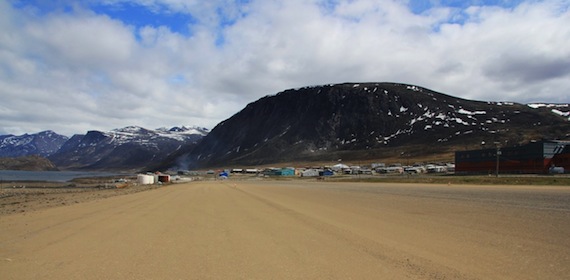Canada’s auditor general slams transport agency for neglecting Arctic airports
Though remote airports are essential for supplying northern communities with fresh food, health care and emergency medical evacuations, Transport Canada is failing to lead efforts to keep them safe and efficient, the Auditor General of Canada, Michael Ferguson, said in a report.
The report is one of seven audits of federal departments and agencies the auditor general tabled May 17 in the House of Commons.
In report number six, the auditor general’s office looked at how Transport Canada has responded to the needs of 117 remote northern airports in Canada.

What the auditor general’s staff discovered isn’t flattering.
“We found that while Transport Canada knew about the infrastructure needs of remote northern airports, it did not lead coordinated efforts to address the unique challenges these airports faced,” the report said.
For the purposes of the audit, Ferguson chose airports in communities where air travel is the only reliable year-round form of transportation, a definition that excludes northern communities on the road system, like Whitehorse and Yellowknife, but which includes Iqaluit.
That includes 25 airports in Nunavut, 17 in Quebec, 17 in the Northwest Territories, 26 in Ontario and one in Yukon.
And after interviewing airline representatives and other stakeholders, as well as studying numerous documents, the auditor general’s office concluded that Transport Canada knows plenty about the needs of northern Canada’s airports.
But despite that, the department has failed to lead efforts aimed at ensuring remote airport infrastructure is maintained and improved.
For example, Transport Canada’s Airports Capital Assistance Program spends only $38 million a year to help the managers of remote airports maintain their facilities.
But that pot of money has not increased in size since the year 2000, and it’s not nearly enough to help northern airports maintain safe lighting, safe runways and weather reporting capabilities.
Nunavut alone needs $463 million, in 2014 dollars, to meet the infrastructure needs of its airports, including $76 million to relocate two airports so they can meet Transport Canada safety regulations, the report said.
They also took note of a big problem in Pangnirtung, where one of Nunavut’s air carriers told them the runway is too short and limits the type of aircraft that can land there.
“This air carrier informed us that it would be modernizing its fleet, and its newer, more powerful and efficient aircraft would not be able to land in Pangnirtung because the aircraft requires a longer runway,” the report said.
Overall, many of the 117 airports the auditor general’s office looked at do not provide enough visual aids to help pilots land safely.
The findings include:
• 44 percent of remote airports do not have approach lighting systems to guide pilots;
• 26 percent do not have lighting to help pilots identify the runway; and
• 21 percent do not have precision path indicators, which help pilots figure out if they’re flying too high or too low when landing.
“Improvements to lighting could enhance airport accessibility and efficiency by helping pilots to better see the runway and land, which could result in fewer cancelled or missed approaches at some airports, especially during periods of reduced visibility,” the report said.
And because of northern Canada’s weather and long, dark winters, those periods of reduced visibility are frequent.
But at the same time, northern air carriers often face difficulties getting reliable local weather information, which compounds the problem created by poor runway lighting.
One airport in Nunavut could not report on local weather conditions for all or part of 96 days of one year.
In the territories, 42 airports were unable to report on local weather conditions in 2015 for an average of 25 days.
And one medevac operator that operates in Nunavut and the NWT said it had to cancel about 360 of 1,250 medical evacuations per year because of poor weather reporting.
Another problem is that only seven of the 117 runways which the auditor general studied are paved, while 94 use gravel runways and others use crushed rock, the report said.
“Stakeholders told us that newer aircraft do not come equipped with gravel kits, which can be costly for air carriers to install,” the report said.
At the same time, aircraft landing on gravel runways must carry 15 percent less weight, in cargo and passengers, and that aircraft parts must be replaced and repaired more often when they operate on gravel.
On the other hand, paved runways cost a lot of money to install and maintain, and some remote communities may not have the skills and equipment required to look after them, the report said.
Another issue that stakeholders are worried about is whether remote airports will get the mobile equipment they need, such as snow-blowers, to keep their runways open in bad weather.
Yet another worry is the future impact of climate change on remote airport infrastructure.
“If the infrastructure is not maintained, it becomes more costly to repair and upgrade. Not addressing infrastructure needs at remote northern airports, which support the only reliable year-round mode of transportation for remote northern communities, also affects the timely delivery of essential goods and public services, such as medical emergency evacuations,” the report said.
To fix these problems, the auditor general’s office recommends that Transport Canada should take the lead in working with stakeholders to develop a long-term strategy for northern airport infrastructure.
The auditor general’s office also recommend that Transport Canada should work with stakeholders to figure out where the money will come from to meet the infrastructure needs of remote northern airports.
Transport Canada says it agrees with those recommendations, but has so far announced no concrete or specific measures to implement them.